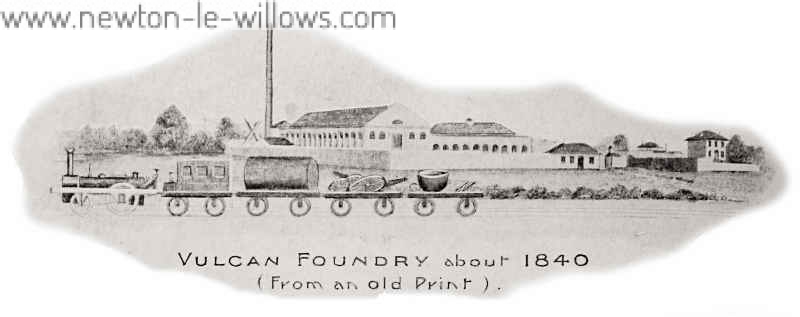In September, 1830, the Liverpool and Manchester Railway was opened, and to digress, here is a brief account of the ceremony. Being one of the first passenger lines in the country, its development must have had a profound influence on the policy and prosperity of the Vulcan Foundry, and the Locomotive industry as a whole during its early years, apart from its interest to all dwellers in South West Lancashire in its effect on the industrial life of the district.
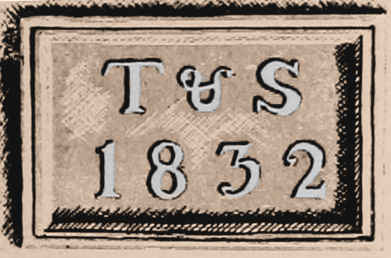 T. & S. Stone. |
| The original stone inscribed T. & S. — 1832, and surmounted by the bronze “Vulcan Visage” representing Vulcan surrounded by lightning flashes, formerly occupied a place over the entrance to the Works and is now preserved in the entrance hall of the Institute. |
 Vulcan Visage. |
The opening ceremony was graced by the presence of the Duke of Wellington, hero of Waterloo, and an imposing array of nobility including the Marquis of Salisbury, the Earl of Wilton, Lord Stanley, Lord Hill and Sir Robert Peel, together with the Lord Mayor of Liverpool and prominent members of Parliament. The proceedings were tragically marred by an accident to the Rt. Hon. William Huskisson, M.P. who was knocked down by the Locomotive ‘Rocket’ and died from his injuries later the same day at Eccles. A tablet to his memory may be seen opposite the spot where the accident occurred at Parkside, Lowton.
George Stephenson had, of course, been resident in the district during the construction of the Liverpool and Manchester Railway, and Stephenson’s cottage still stands at the foot of Emmett’s Brow, overlooking the Viaduct, popularly known locally as the Nine Arches, spanning the Sankey Valley at Newton Common. This valley, at that period a spongy morass, had been one of the chief difficulties in the building of the line, but Stephenson with his northern tenacity would not be gainsaid, and thousands of tons of ballast were poured into the hungry maws of the marsh to ensure a solid base for the foundations of the magnificent sandstone structure still in perfect condition a hundred and twenty years afterwards. Stephenson’s bust stands overlooking the Works on the lawn fronting the offices and a similar model can be seen in the office entrance hall — these busts are reputed to be originals taken from life.
| The firm also had a branch at Warrington at this time, known as the Bank Quay Foundry, and it was here that much of the iron work used in the construction of the Conway Bridge, and the Britannia Tubular Bridge, spanning the Menai Straits was fabricated. Some interesting prints of this work are hung in the south wing of the main office block. |
 |
The first iron sea-going ship was also built at Bank Quay in the year 1852. She was a tea-clipper named -Tayleur,- but was wrecked on her maiden voyage off Lambay Island in the Irish Sea, with a loss of 450 lives. This disaster brought out weird rumours that the event had been predicted by the captain falling down the hold whilst the ship was under construction, and even more sinister, that an evil spirit ran the vessel aground to favour the Carpenters’ Society whose members were naturally perturbed by the substitution of iron for England’s traditional “wooden walls.” A model of the ship’s hull is mounted in the hall of the General Office, together with two lithographs of the ship under sail. Tayleur, however, was not discouraged, and proceeded with the construction of other vessels, and launched from this yard the “Startled Faun,” “Liverpoolania,” “Sarah Palmer” and “Sarah Sands.”
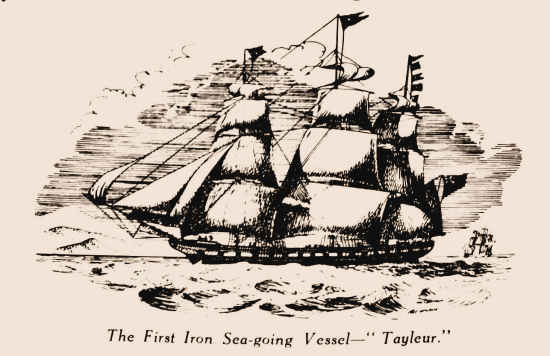 The First Iron Sea-going Vessel—” Tayleur.” |
| Meanwhile, Locomotives were being produced at the Works at Newton-le-Willows, amongst the earliest being the ‘Tayleur” (No. I) and “Stephenson” built about 1831, and taken over by Mr. Hargreaves for use on the North Union Railway, followed in quick succession by the “Warrington,” “Vulcan” and “Newton,” to the order of the Warrington and Newton Railway. |
| The firm is justly proud of the long service records of its workers, many of whom can boast of overfifty years employment with the him. As an example the late:- Josh— Edwards, of the Smithy, had worked here sixty-four years when he retired in 1946, at the age of seventy-nine years. Unique family associations extending into the fourth generation are set out on the “Family Tree” plaques in the Institute entrance hall. For instance, the Harrison family can be traced back to 1840, the Rhodes’ a little later, closely followed by the Singletons, all of whom have descendants working here to-day. |
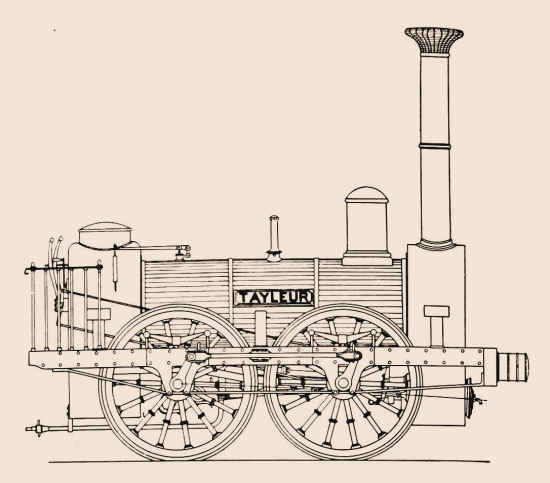 Tayleur Locomotive. |
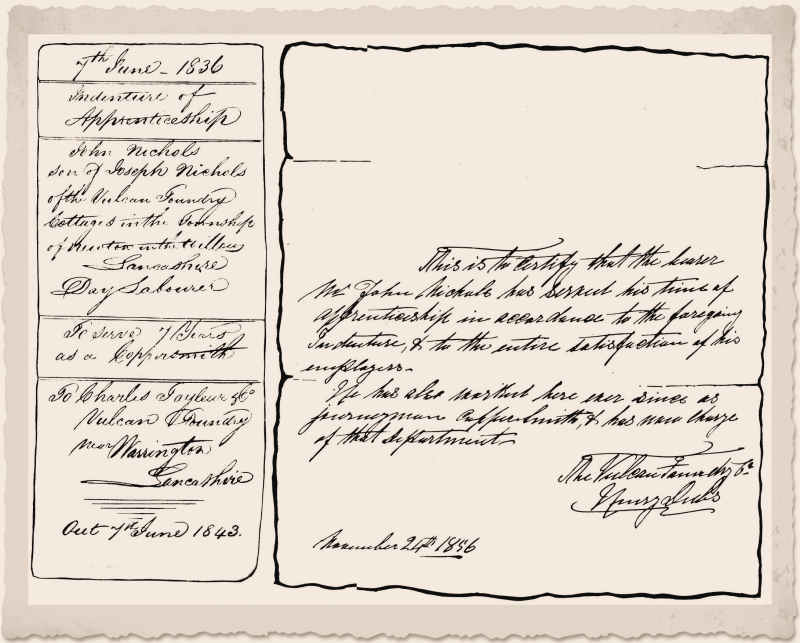 Indenture |
 Indenture |
| Another interesting relic is a form of Indenture dated 1836 in respect of John Nichols, uncle of James Nichols, late Chief Accountant. John Nichols retired from his position as Foreman Coppersmith in 1896, after 63 years’ service. Joseph Ball, a relation of the family and employed here as an Inspector, has in his possession a leather wallet in a perfect state of preservation, inscribed in gold lettering as under :—
“This purse of gold was presented to Mr. John Nichols by his fellow workmen at the Vulcan Foundry on his retirement from Foreman Coppersmith, after 63 years’ continuous service. — December, 1896.“ |
As early as 1835 engines were being shipped abroad, amongst the earliest being eight single drivers for the Paris and St. Germain Railway. In 1837, one of the first Locomotives to run in Russia was built here, a 2-2-2 for the St. Petersburg-Pavlosk Line, and two 0-4-2 goods engines were delivered the same year to the Kaiser Ferdinand Nordbahn of Austria. American orders included three for the South Carolina Railroad, and two for the Raleigh and Gaston Railroad, delivered in 1835 and 1836 respectively. Other early Locomotives were L’Elephant for the Belgian Railways, and four single driver engines for the Berlin and Potsdam Railway.
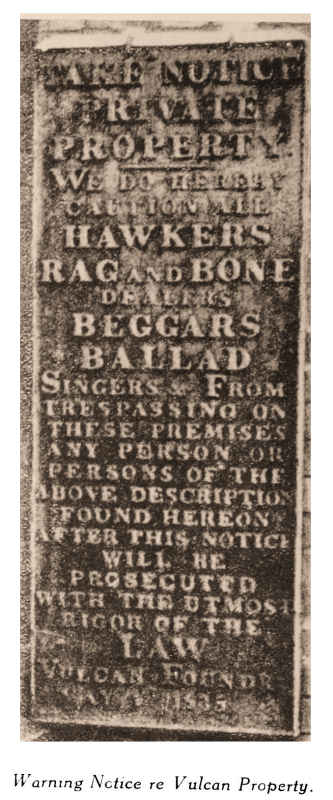 Warning Notice re Vulcan Property. |
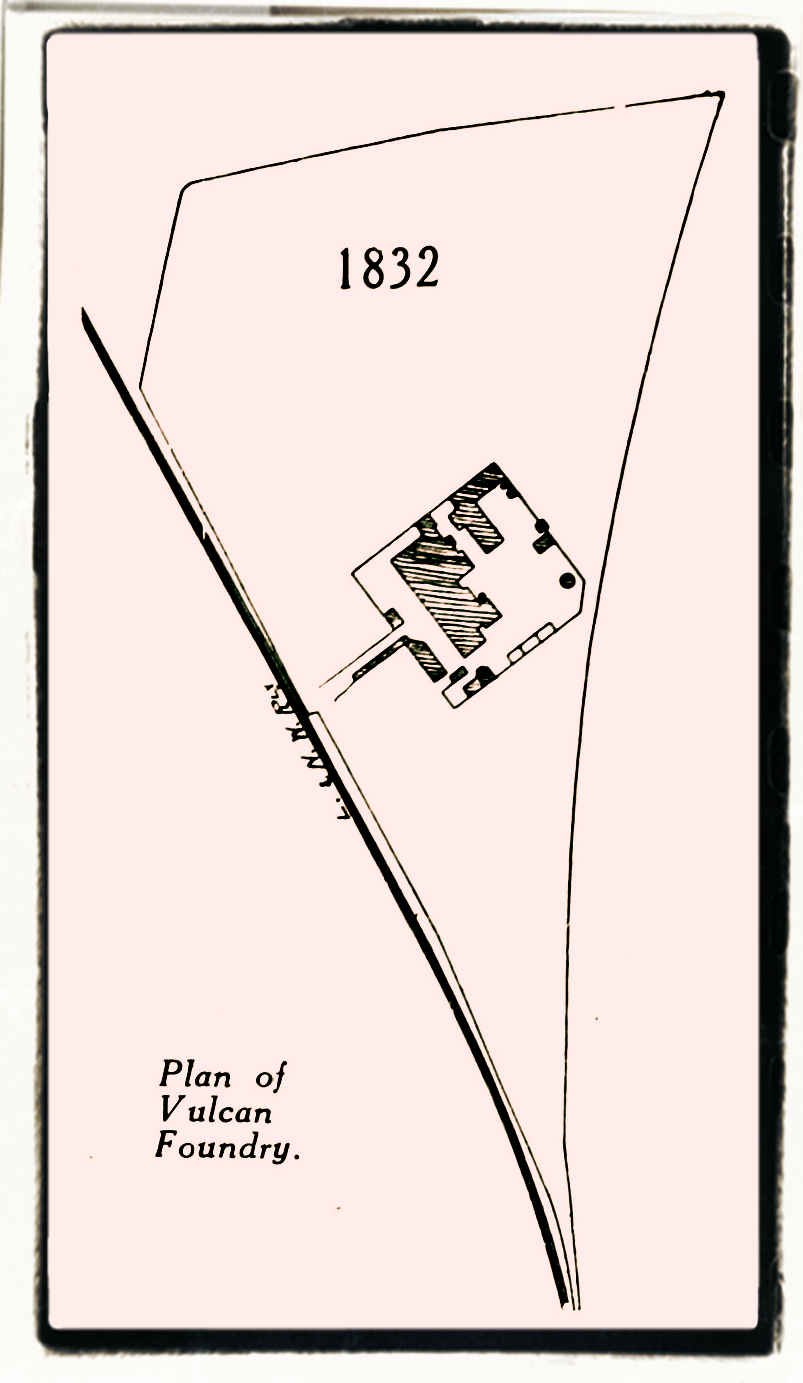 1832 Plan of Vulcan Foundry. |
| At home the Vulcan supplied the London & Greenwich Railway with its first Locomotive (VF. No. 25) and the Jacob Perkins” for the Stanhope & Tyne Railway. In 1837, Vulcan,- “Aelos” and ,-Pacchus- were delivered to the Great Western Railway, these were of seven foot gauge. |
{mospagebreak title=Period: 1837-1865.}Period : 1837-1865.
Subsequent to Robert Stephenson’s resignation, the Works were carried on by Mr. Charles Tayleur, Jun., and later by Mr. Henry J. Tayleur, Mr. Loam being Works Manager at this time. Mr. Dupre was taken into partnership about 1842, and introduced Mr. Henry Dubs as Works Manager. Mr. Dubs was to found the Queens Park Locomotive Works in Glasgow at a later date. Sir Daniel Gooch served is apprenticeship here and was afterwards appointed Locomotive Engineer to the Great Western Railway. Mr. Edward Tayleur joined the Firm in 1843 — Mr. Dupre resigned in 1845 and Mr. George S. Sanderson was admitted to partnership in 1847.
Lane’s History of Newton-in-Makerfleld, gives Edward Tayleur, Esq.. as Chairman of the local board of Improvement Commissioners from 1857 to 1863, thus commencing a long record of notable public service by executives of the Firm—hut more of this anon.
The growth of the new means of transport can be traced in deliveries to the Great North of England Railway, Liverpool and Manchester, Leicester and Swannington, Bolton and Leigh, London and Southampton, Grand Junction, and Leeds and Selby Railways. The Canterbury and Whitstable Railway, the first passenger line in the South of England, opened on May, 3rd, 1830, was taken over by the London and Dover (later South Eastern) Rly., and this line was worked at first and for many years afterwards by six-coupled engines of the long boiler type, which had been built at The Vulcan Foundry.
The earliest side tank engines for any railway, were built here in 1846, for the Waterford and Kilkenny Railway. Then followed a prosperous period lasting to the middle fifties, nearly two hundred locomotives being produced in eight years for such widely separated concerns as the Norwich and Brandon Railway, London and North Western, Chester and Holyhead, Scottish Central, Liverpool, Crosby and Southport, Cork and Bandon, and Vale of Neath Railways.
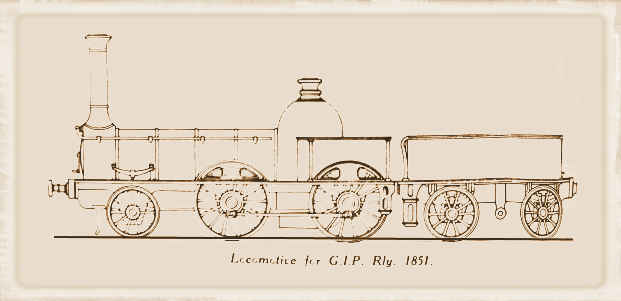 Locomotive fcr G.I.P. Railway. 1851. |
| In 1851, the first passenger tender engines of the Great Indian Peninsula Railway were built at The Vulcan Foundry, and they opened the first public railway in India for traffic between Bombay and Thana on April 16th, 1853. This was the beginning of a long standing connection with India, continuing to the present day, with its standard types for both broad and metre-gauge. |
Two powerful, saddle-tanks for the Rhymney Railway were built in 1861, and as proof of the reliability of Vulcan products, these Engines were in service for forty-eight and fifty years, respectively.
 Diploma. |
| In 1862, a number of single driver express passenger engines were supplied to the South Eastern Railway, and did the run from London Bridge to Dover Town stations in one hour fifty-five minutes, a distance of 871, miles. About the same date, ten single drivers were completed for the East Indian Railway. |
The Firm of Tayleur & Co. was incorporated as a limited liability company in 1864 and under that constitution The Vulcan Foundry has since functioned.
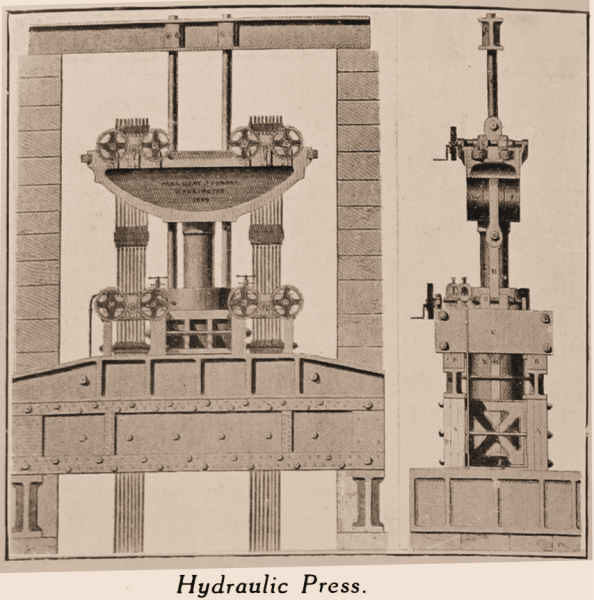 Hydraulic Press. |
| Mr. Charles Tayleur, Sen., had died, Mr. Dubs had resigned, and Mr. Edward Tayleur was now the sole remaining partner, with Mr. Ellis as Manager, to be followed by Mr. W. F. Gooch, younger brother of Sir Daniel Gooch. It was probably this Mr. Edward Tayleur whom -Lane’s History- quotes as being unable to attend a parade of Newton Volunteers, due to falling from a Locomotive on the Warrington and Newton Railway. In the meantime, the Bank Quay Works had been closed and the firm concentrated on Locomotive production at The Vulcan Foundry. |
Unfortunately, labour records of the Company do not appear to have been retained prior to the year 1865, but amongst the more interesting relics of the firm’s history, are a group of -Workman’s Registers,” dating back to that year, and now preserved with other records in the Labour Office. We find that the number of people employed by the Company in 1865 was 537, and a glance through the yellowed pages of these ancienttomes provides a wealth of instructive and at times, humorous information. Even then, the firm’s personnel had begun to develop the cosmopolitan characteristics so much in evidence to-day, for Jonathan Scott, a blacksmith, commenced from Messrs. Hogg and Delametteses, I Rh Avenue, New York City, and workers were attracted to employment with The Vulcan from places as far apart as Glasgow, Dublin, North Wales, London, Coventry, Durham and Bristol.
 Scrumping Apples. |
| It is interesting to note that other local firms still in business to-day provided their quota of labour, and there are records of men entering the works from McCorquodales and the Sankey Sugar Co., in 1865. Harry Lowe, labourer, commenced in February of the same year from “Lord Balcarres Coal Pit,” Wigan. |
A reflection on the morals (or should it be quality of the beer?) of those days, is the fact that over twenty workmen were discharged for drunkenness about this time. We also note that five apprentices “absconded” and a painter, to quote the official records “ran away the same day.” A blacksmith was dismissed for “not working his iron sufficient” and a coppersmith was lent to Evan’s and never returned,- and Edmund Parsonage, a labourer, joined the “Yeomanry Cavalry”, whilst a forge boy was discharged as being “too young to work”.- Two labourers were dismissed for snowballing, and three moulders for “making a disturbance in the Works,” other notices at that time being issued to a boiler maker for “making bad work” and a labourer for “taking one of the other workmen’s rules”-
The shortage of living quarters was evidently just as acute in those days as it is now, for we find that three blacksmiths from Liverpool had to leave because they “could get no lodgings.- There is something piquant about a forgeman and two strikers being discharged for “stealing fruit,” and the spectre of the closed-shop must have been visible in November 1865, when a rivetter was dismissed for “refusing to work with a holder-up not being a club man.” The most unsatisfying account is of a striker who absconded after assaulting ‘Patsy’, for we are left to guess Patsy’s identity and the extent of his injuries.
In addition to the families mentioned in the first instalment the forerunners of a number of well-known “Vulcanites” commenced with the firm about this time, amongst the more prominent names being those of Sweetlove, Roberts, Boughey, Houghton, Crane, Jones and Lawson.
{mospagebreak title=Period: 1866-1895}Period : 1866-1895
Ten broad gauge saddle tank engines were built at The Vulcan Foundry in 1866-7 to the order of the. Bristol & Exeter Railway. They had 5 ft. 6 in. coupled wheels, 8 ft. 6 in. wheelbase, and in addition to the 530 gallon saddle tank another tank below the footplate carried 740 gallons of water. The footplate was placed very high over the trailing axle, and access to it was obtained by ladder-like footsteps in front of the trailing wheels. The weight of this engine in working order, was 47 1/2 tons.
 Locomotive for Bristol and Exeter Rlys.1867 |
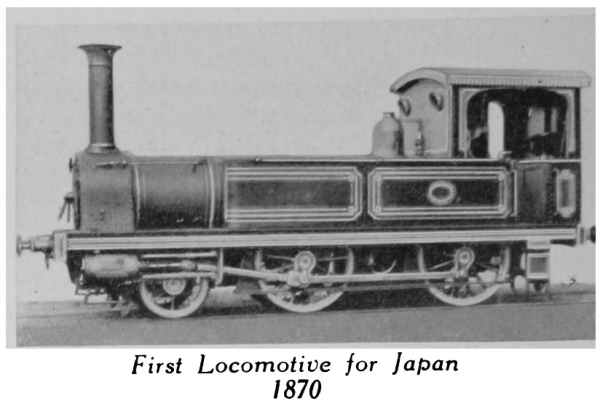 First Locomotive for Japan 1870 |
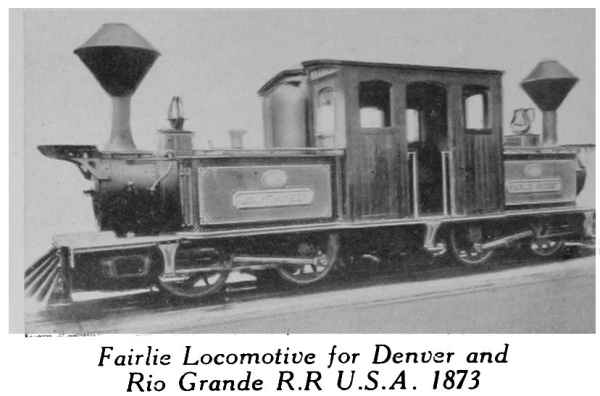 Fairlie Locomotive for Denver and Rio Grande R.R U.S.A. 1873 |
It is not generally known that the first Locomotive to run in Japan was built at The Vulcan Foundry in 1870. This was a side tank engine with 4 ft. 3 in. coupled wheels for the Imperial Railway of Japan, working the line between Tokio and Yokohama. It was followed later by an order for six coupled tender engines whilst later still, a number of side tank engines were supplied for the Sanyo Railway in Japan.
The Fairlie Patent double Locomotive came into use in 1865, and the first engines of this type were built at The Vulcan in 1872 for the Dunedin and Port Chalmers Railway, New Zealand. They had double boilers, with the firebox at the centre, the barrels running fore and aft, and two four-wheeled bogies each with its two cylinders arranged at the outer ends of the frame. Built for 3 ft. 6 in. gauge these engines weighed about 30 tons. The Fairlie type was adopted on various gauges of railway, and a Fairlie engine was constructed for the mountain section of the Denver and Rio Grande Railway, U.S.A., by The Vulcan Foundry in 1873. Other Fairlie types were built about this time for Mexico, Portugal, Norway, Queensland and Peru. The Vulcan introduced some important improvements to the Fairlie engine, and in a modified type for Burma, the two boilers were separate, placed back to back with a footplate between, and carried on a deep girder frame at the extremities of which the bogie pivots were arranged 8 in. behind the bogie centre, instead of at the centre as was formerly the practice.
 Vulcan Works and Village about 1890 |
| The difficulty of shipping locomotives in the early days must have been tremendous as the accompanying print shows, partly dismantled engines were slung aboard the old wind-jammers by block and tackle, with the help of a vertical donkey engine. |
To alter the sequence of events a little, a word at this stage about the Vulcan Village may not be out of place. The first cottages were built about 1832, and plans are still in existence of additional cottages erected in 1847. The Village is now a self contained community, comprising 114 cottages, complete with school, stores, post office, and Inn, the whole surrounding the traditional Village Green. An old print of sixty years ago shows the communal wash-house, standing approximately where the patch of greensward now confronts the village school; the same photograph depicts the manager’s house surrounded by trees, on land now occupied by the Forge, and the “T. & S.” Stone can be discerned on the gable end of what is now the small turning shop.
Before the extensions to the Works, the Village must have presented a delightful sylvan picture with just beyond its confines the limpid waters of the Milling-ford Brook flowing to its confluence with the Sankey. The Brook is the main outlet for Newton Mere and over thirty years ago, before the lake was polluted, I have happy memories of lifting roach up to a pound weight from the stream with my bare hands during the dinner hour!
Amongst records of long service with the firm, that of an old village worthy in the person of the late John Lawson, stands supreme. John was born at 28 Manchester Row, and lived there all his life. In 1923, he was placed third in a long-service competition organised by the Liverpool Evening Express,” and had at that time 69 years’ service with The Vulcan Foundry, but he continued work up to December, 1927, when he retired with 73 years and 5 months service at the ripe age of 85, unfortunately passing away only a few weeks after his retirement. A truly notable record of service especially when one realises that he had an arduous life as a Blacksmith’s Striker.
To deal with the traffic over the Suburban lines and Metropolitan extensions of the London, Chatham and Dover Railway, a very suitable design of side-tank engine was introduced by the Locomotive Superintendent, Mr. William Kirtley, and a contract for several of these was placed with The Vulcan Foundry in 1875. They proved so efficient in service, that most were still running when electric traction was substituted for steam in the Southern Railway, London area.
Four powerful eight coupled side-tanks were built in 1879 for the Seville & Jerez Railway, now part of the Northern Railway of Spain. In 1880. the 4-4-0 type of passenger tender engine was introduced on the Lancashire & Yorkshire Railway, and a considerable number were built by different firms to Mr. Barton Wright’s design. Thirty-five were constructed at The Vulcan Foundry; twenty in 1884 and fifteen in 1886.
The first ten-wheeled tank engines with inside cylinders were built at The Vulcan in 1888 for the Taff Vale Railway, and initiated a type which became extensively used. They were the first engines built at the Vulcan with the cylinders cast en bloc, each engine weighing 54 tons each in working order. In 1890, The Vulcan Foundry delivered five passenger tank engines to the Rhymney Railway, which were unique in being the only engines in this country with saddle-tanks combining the features of the 2-4-2 wheel arrangement, with double frames to all wheels, except the trailing pair.
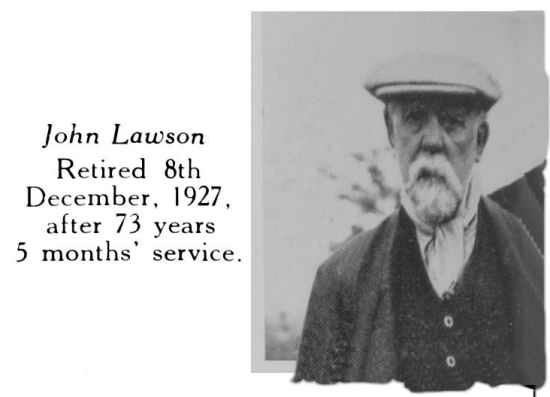 John Lawson |
| When the Indian Midland Railway was completed in 1889 a large proportion of its locomotive stock was built at The Vulcan Foundry. Ten 2-6-0 tank locomotives were |
put on the line in 1889 for assisting trains on the sharp inclines of the Ghat section, over the Vindhya Hills leading into Bhopal State. They were of somewhat novel appearance, as the tanks projected well in front of the chimney. Twenty-four 2-6-0 Tender Engines were supplied to the same railway in 1894-6, and at that time were considered the last thing in locomotive design. They had extended smoke-boxes of taper form, and two of this design, loaded for delivery, can be seen on the aforementioned photograph of the village and its confines about sixty years ago.
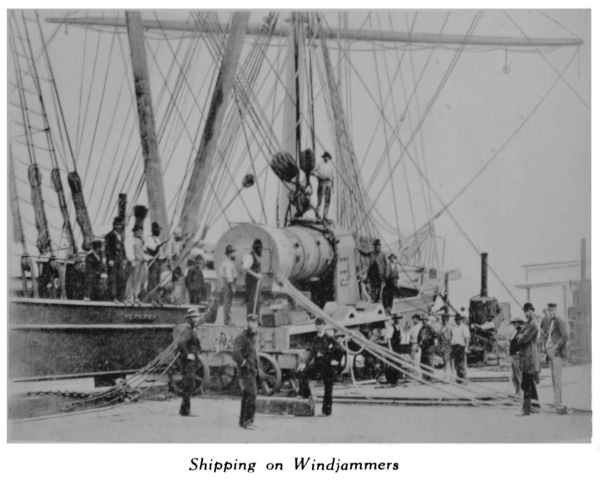 Shipping on Windjammers |
| Also in 1893-4, twenty standard goods engines were built for the London, Brighton & South Coast Railway; they were fitted with Westinghouse Brakes, and during the Summer were frequently used on heavy passenger trains, running quite steadily at 55 miles per hour.
The Vulcan Foundry labour force at this time was 555. |
{mospagebreak title=Period: 1895-1914}Period: 1895-1914.
| The Company had now been founded over 60 years, and its products had been delivered to most parts of the globe—a firm footing had been established in countries as widely separated as India and South America, and the quality of the firm’s goods had resulted in The Vulcan taking a major position amongst the world’s Locomotive Builders.. |
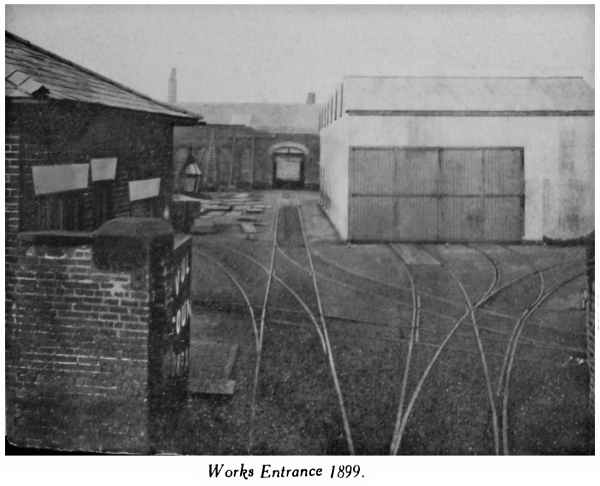 Works Entrance 1899. |
Sir (then Mr.) William Collingwood, had taken over the management from Mr. W. F. Gooch, and under his direction, the Works were rapidly extended, and the personnel duly increased—in 1905 the labour force had been built up to 1,390. There can be no doubt that Sir William Collingwood’s engineering skill and organising ability contributed largely to raising the Company to such a favourable position in the Locomotive industry. He was intensely interested in the subject of Locomotive design, he was original in thought, and possessed a charm of manner which endeared him to all with whom he was associated. He was the son of Mr. George Collingwood of the Hon. East India Company’s home establishment, and a descendant of the famous Admiral Collingwood, and was born in London 1855. In 1872 he entered upon a pupilage under Mr. W. Adams at Bow on the North London Railway for two years, and afterwards at Stratford on the Great Eastern Railway for three years. In 1878 he joined the East Indian Railway as Assistant Locomotive Superintendent, and subsequently rose to the rank of District Locomotive Superintendent ; before leaving India in 1892 he acted as Chief Locomotive Superintendent. During the greater part of his service in India, he was in charge of the Allahabad district, covering some 900 miles of line.
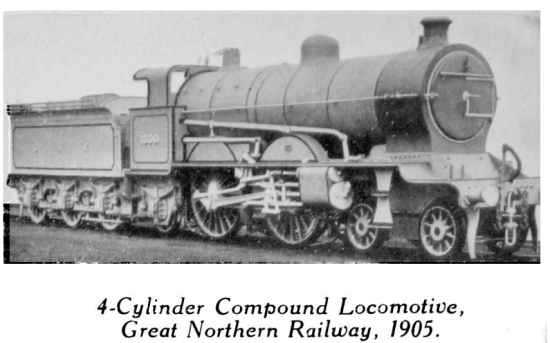 4-Cylinder Compound Locomotive, Great Northern Railway, 1905. |
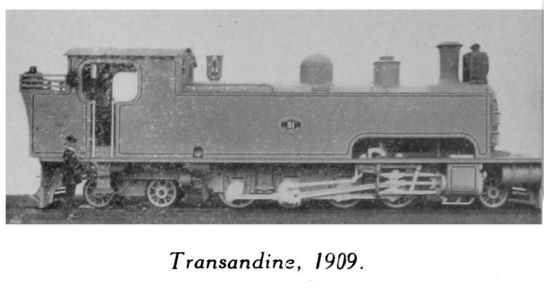 Transandine, 1909. |
| He held the post of Manager of The Vulcan Foundry until 1912, when he was appointed Managing Director. Apart from his engineering associations Sir William, following earlier executives of the firm, took a keen interest in public affairs, and for many years was a member of the Lancashire County Council. He was elected President of the Manchester Engineering Employers’ Federation in 1913, and during the first World War was Chairman of the Manchester and District Armaments Output Committee. He was created a Knight of the Order of the British Empire in 1917. |
It was part of my duties as a boy, to open the morning correspondence for Sir William, and he always had a cheery word for the juniors when entering the office. One winter’s day, another junior and 1 discovered that a certain executive had, very unwisely, left open his cupboard containing a half bottle of whisky which, withyouthful bravado we proceed to sample. When Sir William chanced to remark that we were in good ”spirits” that morning, he little knew that he was so dangerously near the truth.
| Vulcan Foundry Reserves c1900 Top Row—Hulse, Kenning, Symonds, Batorm, Topping. Boardman and Greenall. Centre–Lowe, Greenall and Powell. Bottom Row—Harrison. Ellis, Taylor. Thompson and Broster. (This team played behind the reservoir where the Pattern Shop is situated.) |
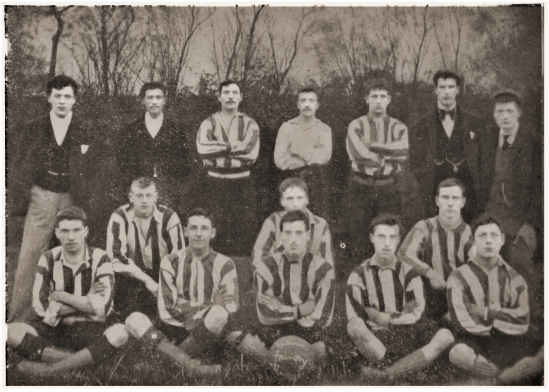 |
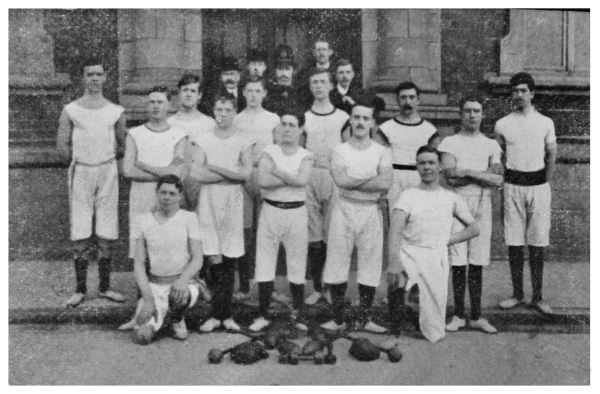 |
| VULCAN GYMNASIUM COMMITTEE AND SENIORS, 1910. T. Harrison, W. Jones, P. C. Lambert, A. Blackburn, J. Withington, J. Baker, E. Marsh, A. Baker, S. Findley, S. Lyth, P. Burns, G. Harrison, T. Dennett, J. Brindle, J. Bate, T. Baker, A. Ball and A. Dennett. |
One of the workers, Mr Sansom recounted some memories from this period, he states “Mr. James Nichols was Chief Accountant during my early years; his grim countenance and gruff voice hid a kindly heart. He once suspended me for a fortnight for some boyish prank, and to my surprise and delight, paid me for it.
Mr. Tom Fairclough was second-in-command to Mr. Nichols. He was known as ”Gammy” Fairclough, due to his propensity for writing with his left hand, but he was ambidextrous, and could write equally well with either.
Mr. Willan was Works Manager for a while ; he had a steam-car fired with coke from the rear end of the chassis, and the story goes that he pulled-up to give a lift to the then Chief Draughtsman, Mr. McLay, but Mr. McLay declined the offer, stating that he was in a hurry ! This was before the era of motor transport as we know it to-day, and packing cases were taken to the Goods Station by horse and cart, a labourer taking the smaller parcels by wheel-barrow.
Old Tom Carter was in charge of the stables, which were situated where the lecture room stands to-day. I occasionally ran errands for him, and he used to reward me with a handful of horse-beans!”
The Vulcan Institute was opened in 1907 and except for the addition of forty-eight feet to the length of the main dining hall at the east end, outwardly appeared then much as it is to-day. We have had passed on to us a programme of the “First Popular Concert for Members and Friends” held in The Vulcan Locomotive Works Institute on Saturday, November 28th, 1908. The artists taking part included the Misses M. Jackson, J. Howard & A. Grissold, Messrs. A. R. Hill, A. Grissold & W. Hems with a choir conducted by Mr. R. J. Hughes and the accompanist Miss D. Profit.
To revert to Locomotive Production, thirty mixed traffic 4-6-2 tender engines were built in 1902-3 for the Western Australian Government Railways. The Great Western Railway had imported a French express engine in 1904, and The Vulcan Foundry were invited by the Great Northern Railway to submit designs for a 4-cylinder Atlantic type balanced compound engine on the De Glehn system, for trial, to prove that British Engineers could do as much as the Continental. The design was accepted, and the engine, after delivery, was subjected to exhaustive trials alongside simple engines of the same general type, and showed decided advantages in economy. Two features peculiar to this engine, were the; Vulcan Patent Starting Valve and Reversing Gear. After hearing the result of the trials of this engine, the Buenos Ayres Great Southern Railway ordered eight of a somewhat similar type.
Some powerful 2-8-0 goods engines were built for the broad gauge Indian Railways in 1907 andgave a good account of themselves hauling heavy loads over certain sections of the Bengal Nagpur Line. A considerable number of standard 0-6-0 goods engines were delivered to the North Western Railway of India in 1908, and these proved very efficient on mixed traffic duties. For the difficult transport of all kinds of traffic over the Argentine Transandine Railway, which operates on the Eastern slopes of the Andes, three powerful 2-8-4 side tank engines were built by The Vulcan Foundry in 1909, to suit the metre gauge track. During this period, considerable developments were made in tank engine designs and a series of large standard 2-6-4 side tank engines were delivered to the East Indian Railway for heavy fast local traffic, with its accompanying frequent halts.
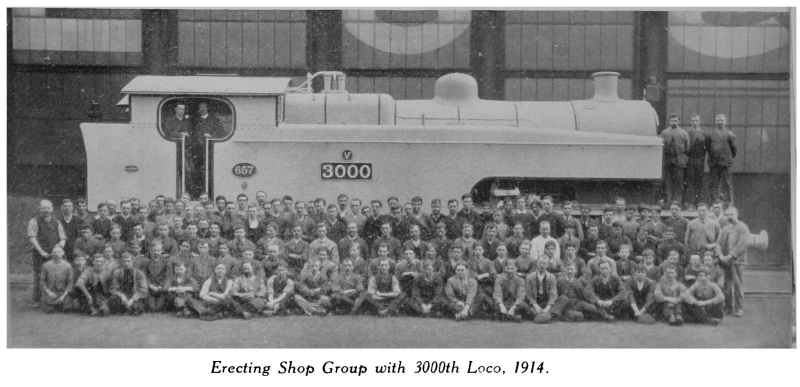 Erecting Shop Group with 3000th Loco, 1914. |
| A much lighter 4-4-4 tank engine for the Central Uruguay Railway was built in 1913, and in 1914 the 3000th locomotive, a large 2-6-2 broad gauge tank engine for the Great Indian Peninsula Railway was completed. |
{mospagebreak title=Period: 1914 WW1 and after}Period: 1914—THE FIRST WORLD WAR AND AFTER.
LOCOMOTIVE production was to some extent interrupted during this period, and a good deal of the plant was turned over to the production of Paravanes, Shells and Gun Mountings, for the Admiralty and War Office.
| The ”Paravane” or ”Burney Sweep” was an anti-mine device, and as far as I recall they were used in pairs, being attached to the bows of the vessel using them by wire hawsers and floating some distance from the hull, the mine thus being disposed of at a safe distance from the ship. Commander Burney, the inventor, was a regular visitor to the Works at thistime, and if my memory serves me right his son, who was also a high ranking naval officer, occasionally accompanied him. |
 A Paravane |
The rings by which the nose and tail-pieces of the paravane were attached to the body, had to undergo stringent water pressure tests, and I recall one naval -brass-hatbeing deposited in a recumbent position on the other side of the shop when hit by a jet of water from a “blow-out.” A specimen “Paravane” has been preserved, and hangs from the rafters of the Institute Concert Hall. I have heard this referred to by the uninitiated, as a “torpedo,” and even as a -flying bomb.-
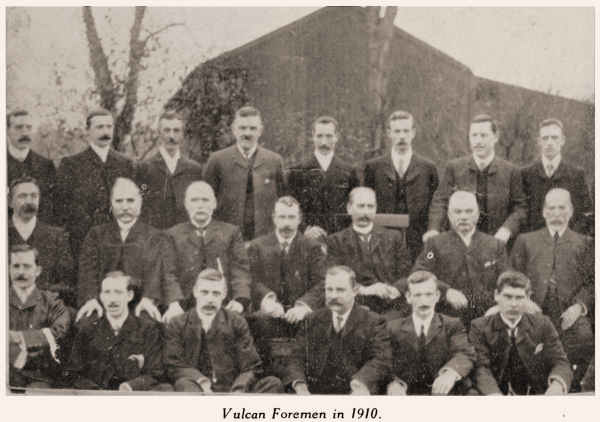 |
| Vulcan Foremen in 1910.
Back Row : W. Sutton (Fitting), J. Siddeley (Pattern), T. Astall (Turners), T. Travers (Boiler), J. Clarke (Machine), J. Derbyshire (Machine), J. Ardern (Auto), T. Rhodes (Copper). |
Shells were turned out in vast quantities, most of the machining being done by women and girls in the Automatic Shop, under the supervision of Miss Fawke, whilst Mr. Eachus was responsible for the production side. My brother, who was a naval rating during the 1914-18 war, informed me that the breech blocks of the guns in the forts flanking Portsmouth Harbour were made at the Vulcan Foundry. In addition to heavy naval gun breech blocks and mountings, a considerable number of 2 pounder anti-aircraft pedestal guns were built in the Tender Erecting Shop, whilst another contribution to the war effort was the production of metal ammunition boxes.
Although we had many air-raid scares at this time, I think the nearest bombs were dropped on the outskirts of Wigan and St. Helens, when a Zeppelin jettisoned its load over these areas. The then Chief Accountant dashed into the office one day frantically exhorting to us to put our books away, and make for cover as a Zeppelin had been sighted, but it turned out to be one of our naval -Wimps- on exercises. The -Blimp- was a non-rigid type, and it was some years later that this country developed a successful rigid airship at the base at Carding-ton in Bedfordshire. I remember a ship of this type, the R33, passing over the Works many years ago, itsvast bulk slipping through the mist and appearing to almost graze the Forge chimneys in its passing. I think it was this same airship that later broke her back over the Humber, with the loss of many lives.
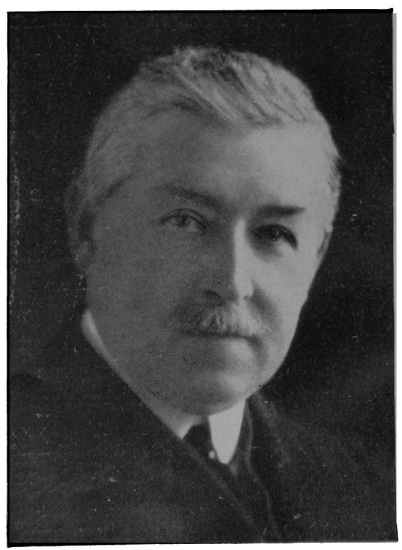 Mr. Richards |
|
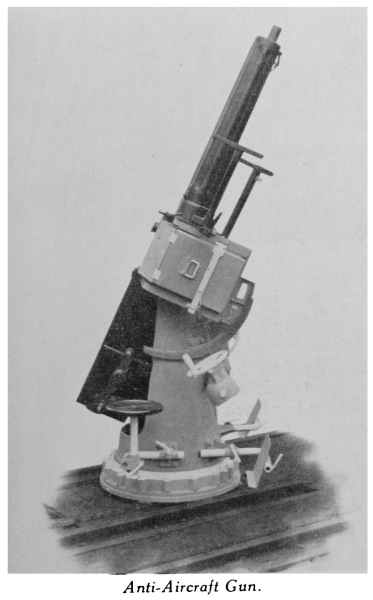 Anti-Aircraft Gun. |
Despite the bustle of war production, Locomotives were not entirely forgotten during this period, and a series of five large side tank Engines for the Taff Vale Railway were built in 1916. |
Mr. R. P. Richards, who had been Works Manager since 1904 and General Manager from January 1917, was a strict disciplinarian, but a just man,
Another office-boy and myself decided to ask Mr. Richards’ permission to fish ,the reservoir, and we —tossed-up’ as to who should be- spokesman, the lot falling to my partner. Unfortunately he had a’speech affliction, and when we entered the “holy of holies” the occasion proved too much for him, and he could only open his mouth and make. a singular hissing noise. The more he hissed, the more Mr. Richards fumed, and the more Mr. Richards fumed, the more the unfortnate fellow hissed, until after an agonising few minutes I had to fill the role of spokesman. Strange to relate our request was granted.
Four of us, three of whom shall be nameless, were caught red-handed by the then Works Policeman, P.C. Clarke, stealing applesfrom Mr. Richards’ garden, during the dinner – hour. My fellow criminals safely negotiated the corrugated iron fence surrounding the garden, but I unfortunately got hung up on the serrated edge by the seat of my trousers ! As a result we were hauled in front of the Works Manager, Mr. Lane, and whilst my three partners were each fined 2/6 for their misdeeds, I was let off with a caution on account of the damage to my person!
Just after the termination of the Great War, thirty-five “Consolidation” goods engines were built to the order of the French State Railways. These were fine locomotives as the accompanying print shows.
The Great Indian Peninsula Railway, in common with several other Railways, commemorated those of its servants who fell during the Great War, by attaching a symbolic name and inscription to one of its express engines. The Locomotive bears the name “Hero” and is inscribed -In memory of G.I.P. Railway employees, who gave their lives in the Great War 1914-1918.- This Engine was one of an order, executed by The Vulcan Foundry in 1921—it was equipped with oil fuel burning apparatus, but arranged to permit of ready conversion to coal firing if necessary.
An interesting development in Locomotive design at this time was the construction of Tender Locomotives specially designed for mixed traffic work. In 1921, Mr. L. G. Robinson, Chief Mechanical Engineer of the Great Central Railway, brought out a series of four-cylinder Engines, of this type, for working fast and heavy fish expresses between Grimsby and London, and of suitable proportions for passenger services also. Several of these Engines were constructed at The Vulcan Foundry.
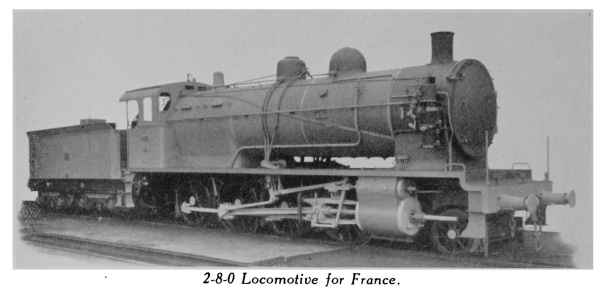 2-8-0 Locomotive for France. |
| It is interesting to note that after well over thirty years’ service on the Midland system, certain Locomotives built by The Vulcan Foundry between 1870 and 1874, were sold to the Italian State Railways in July, 1906, others were in service with the London, Midland & Scottish Railways up to 1930. |
As a further proof of Vulcan quality, Mr. Gemmell, of Messrs. Heatly and Gresham, our agents in Calcutta, has forwarded a list of Vulcan veterans at present working on the East Indian Rail-way, for example a “P” Class Engine. placed in service in 1905, had a booked mileage of 1,612,027 miles up to December 1949, whilst an “SGC” Class built in the same year had done 1,713,971 miles.
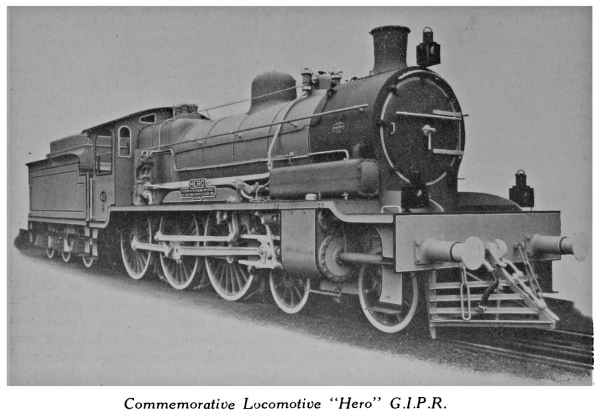 Commemorative Locomotive “Hero” G.I.P.R. |
| Twenty 4-8-0 Type Engines for the metre gauge Uganda Railway, Kenya Colony, were built in 1922-3, fifteen designed for oil-fuel burning and the remainder for coal.
The labour force at this time was 1850. |
{mospagebreak title=Period: Between the wars}Period: BETWEEN THE WARS
For some years after the termination of hostilities, work continued at high pressure at The Vulcan Foundry, a full order book being maintained, due to the world shortage of Locomotives and Spares as a result of the war. Orders for a large number of the Indian Standard design of 2-8-0 Type goods Engines were placed with British manufacturers, a good share of these coming to The Vulcan Foundry.
A very useful six-coupled side-tank engine of neat design was introduced by the London, Midland & Scottish Railway in 1924, and one of the first contracts placed was for twenty with The Vulcan Foundry. Although described as a goods Tank Engine, later examples are in regular service on passenger trains—I believe some are still in use on the local Warrington motor train service.
Considerable development of the Gold Coast Railway took place after the war, consequent upon the expansion of the mining industry in that country. To work the heavy trains of machinery and stores, some powerful 4-8-2 Tender Engines were built by The Vulcan in 1924.
 Sir Hugh Clifford |
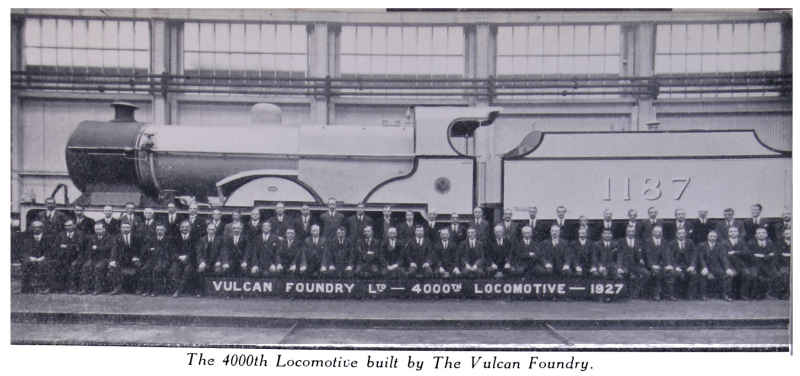 The 4000th Locomotive built by The Vulcan Foundry |
| The increasing weight of main line passenger trains on the East Indian Railway, necessitated higher powered engines, and a number of 4-6-0 superheated Locomotives for the 5 ft. 6 in. gauge were supplied by The Vulcan Foundry in 1925. Another example of a powerful goods engine, is shown by the illustration of the Locomotive for the Nigerian Railway. |
In the early twenties, as many of the major Indian Railways began to come under the control of the Indian Government, a Committee was appointed to carry out a policy of locomotive standardisation, detailed designs of the new standard locomotives were worked out by the locomotive builders and the Conulting Engineers, the broad gauge engines being designated as “X” class, the metre gauge as “Y” class and the 2 ft. 6 in. gauge as “Z” class. The Vulcan Foundry were engaged on the design of the “X” series, of which, the first to be completed were nine 4-6-2 “XB” class for G.I.P.R. and five for the E.B.R. in 1927. These were followed by 2-8-2 “XD” class, 4-6-2 “XC” class, 2-8-2 “XE” class and 4-6-2 “XA” class for various Indian Railways, and also in 1927, five of the 2-8-2 “YD” class were supplied to the Assam Bengal Railway.
In 1923, Mr. Richards retired from the position of General Manager and joined the Board of Directors, Mr. F. S. Whalley being appointed as his successor. Sir William Collingwood retired in 1928. Mr. Whalley became the Managing Director in June, 1929.
In those days, as now, the bicycle was a popular means of transport to and from the Works, and before the advent of ‘buses, was indeed in many cases, a necessity. Mr. King, then Assistant Works Manager, had a de-luxe model cycle, the handle bar grips of which, screwed out to reveal an oil can in one and a repair kit in the other.
The late Simeon Hayes affected a fixed-wheel museum piece, the brake operating by means of a rubber covered shoe pressing down on the front tyre. He could never mount this machine unaided, and Sam Hough, then foreman Millwright, took a fiendish delight in getting him into the saddle and attempting to push him into the Institute wall!
It was the practice of the clerks to rear their machines in front of the offices, leaving the juniors to take them through the lodge-gates to a place of safety under the office veranda. (We had not then attained the luxury of bicycle-sheds). One summer morning, instead of turning in at the gates, set off on a tour of the surrounding countryside, and had reached the outskirts of Warrington, when I was horrified to see Mr. Richard’s Rolls Royce bearing down on me. In reply to Mr. Richard’s brusque query as to what I was doing so far from the Works, I explained that I was “taking Mr. Marsden’s bicycle round, and this reply so nonplussed him, that he could only order me to return to my duties forthwith, and omitted to mete out any further punishment. However, the day afterwards, an edict was issued to the effect that cycles must not be left in front of the Offices.
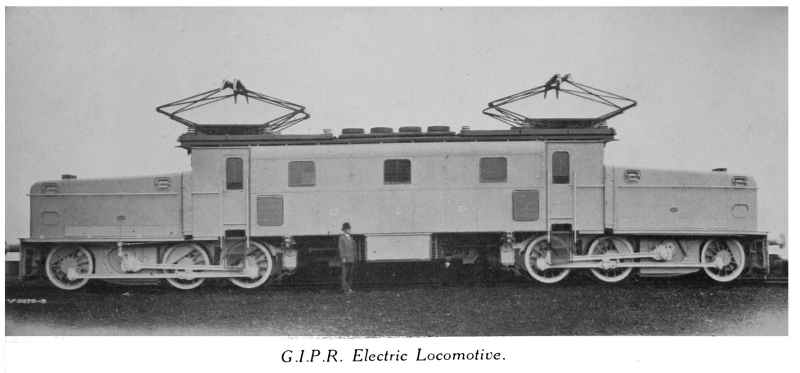 G.I.P.R. Electric Locomotive. |
| The first ‘buses were far removed from the fine coaches that operate to-day, they had solid tyres and passengers sat facing each other along the length of the vehicle and with unfailing regularity each Friday, the Cashier used to receive from a certain foreman a request to pay a number of his men early as they travelled by “buzz”—busy little bees evidently! |
The late Chief Accountant, Mr. Nichols, developed a consuming passion for golf and used to practise swings in the privacy of his oil:ice, but discontinued this habit after almost decapitating me with a No. 5 iron as I was taking in his afternoon tea. Personalities I recall in the Works include Tim Traverse, Foreman Boilermaker, a huge man and an awesome figure in his boiler inspection suit, Mr. Gill, one-time Foreman Erector, always immaculately attired with a flower in his coat and his son Jack, the chief Rate-fixer, who met an untimely end. The aforementioned Sam Hough, never without a quid of tobacco in his mouth, and Tommy Abbey, the bent and wizened Foreman Labourer.
Jack Martin, the one-legged Foreman Planer, affectionately known as “Peggy”, whom I once instructed to “take his barrow up to the Goods Station,” having confused him with Martin McGuinness the old Labourer who normally performed that duty!
Some indication of the expansion of the business is given by the figures showing Works output. Although the 1000th Engine was completed in 1883, it was twenty-two years later that the 2000 mark was reached. The 3000th Engine, a tank Locomotive for the Great Indian Peninsula Railway, was delivered in 1914, and the 4000th Engine, a three cylinder compound for the London, Midland & Scottish Railway, was completed in 1925. In view of the fact that Locomotives had become much heavier, the tonnage production figures are relatively greater than shown by the mere increase in the number of Engines delivered.
With the extension of Electric Traction on Railways it was obvious that Electric Locomotives would be required, and the firm gave particular attention to this new development. About this time, contracts were secured for the supply of mechanical parts for thirty-one heavy Electric Freight Locomotives for the Great Indian Peninsula Railway. Each Engine had motors totalling 2,600 H.P. and weighed 123 tons, and was built to run at a maximum speed of 45 miles per hour.
In 1930, the Firm completed one hundred years of Locomotive building, and to celebrate the centenary, the Directors invited all the employees, numbering some 2,200, as their guests for a day’s outing to Blackpool, the special trains employed being drawn by Locomotives built at The Vulcan Foundry, chartered for the occasion. Of the numerous stories told of the trip, perhaps two will suffice. A certain clerk, having imbibed more beer than was his wont, stood glassy-eyed and rocking on thepromenade. He was approached by a boatman with the remark “Nice day for a sail, Sir.- Our friend appeared to ponder this remark for a while, and then replied “Hic—b well go for one then !
| An hilarious party wending their way to the station for the train home, spotted a figure lying prone in the gutter, which on closer investigation proved to be one of their own workmates who had dined “not wisely but too well.- He was picked up and carried to the train, and on arrival at Earlestown, two of the party volunteered to see him to his home. After much fruitless knocking, the bedroom window of the house next door was flung open and an irate feminine voice bawled down, “It’s no use knocking there, they’re all gone to Blackpool for the week.” |
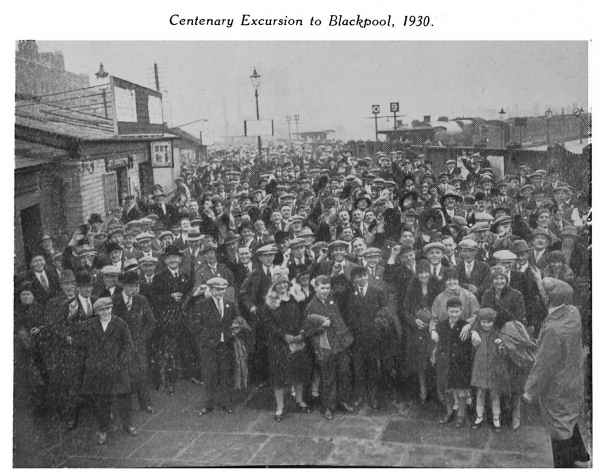 Centenary Excursion to Blackpool, 1930 |
{mospagebreak title=Period: 1930s, WW2 and later}Period: THE 1930’s — THE SECOND WORLD WAR — THE “LIBERATION”
The Argentine Railways since the early days, had obtained economical results from the use of two-cylinder compound Locomotives for long hauls, and in 1930 twenty 2-8-2 Engines of the C.S.9.A. Class were built at the Vulcan for the Central Argentine Railway, followed by an order for twenty 2-8-0 Locomotives in the same year for the Buenos Ayres Great Southern Railway. During 1934-5, one hundred Class 5 Engines were delivered to the London, Midland and Scottish Railway and they were an outstanding example of the tendency to develop a first-class Mixed Traffic Locomotive capable of hauling any kind of train. The tapered boiler barrels lent an air of power and distinction to these very neat looking engines.
| Twenty-four remarkable locomotives were built in 1935 to the order of the Chinese Government Purchasing Commission for service on the Chinese National Railways. They were the largest engine built at the Works to that date, and had a wheel arrangement of 4-8-4 with an overall length of engine and tender of 93 ft. 21/2 in. Six were equipped with booster engines driving the rear axles of the leading tender bogie and of the remaining engines the rear bogies of the locomotives themselves were adapted for the ready application of a booster if required. |
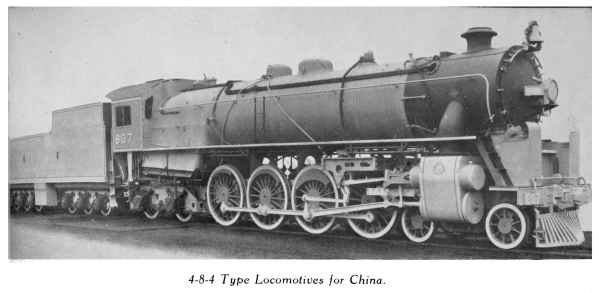 4-8-4 Type Locomotive for China |
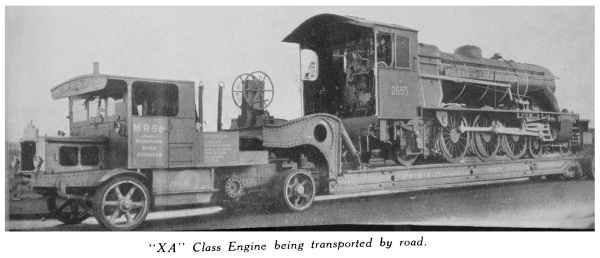 XA Class Engine being transported by road. |
| Though the largest in overall dimensions, they were not the heaviest engines built at Vulcan–the engine and tender in working order weighing 192 tons. Sixty-nine powerful 2-8-0 Freight Locomotives were delivered in 1936 to the London, Midland and Scottish Railway. They had taper boilers, and were to the design of Sir William Stanier and required mainly for handling heavy coal trains in the Midland Division. |
I find that I have rambled on with my personal reminiscences, very often at the expense of matters of more moment, in the Firm’s history. For instance, I mentioned in passing, the transportation of locomotives by road, but I should have stressed that the Vulcan Foundry were the pioneers of this method of transport and that when the first Engine (4-6-2 XA Class for India) so despatched left the Works in January, 1930, it was a matter of front page interest in the National Press and the premises were beseiged by an army of reporters and photographers.
Again, in mentioning old employees of the Firm, I overlooked the case of Joseph Roberts who died so tragically in India in June 1929. Joe had over forty years’ service with the Vulcan Foundry and had travelled many thousands of miles in his capacity of Firm’s representative in the supervision abroad of erection of locomotives. He was held in high esteem by all who came in contact with him, and the following extract from the Indian Press at the time of his death gives some indication of the respect which he had inspired : —
ROBERTS—Joseph J. Roberts of Vulcan Foundry, Lancashire, died on 10th instant, at European General Hospital after a short illness. Deeply regretted by the Indian Staff working under him at G.I.P. Workshop, Parel, for losing a good-natured officer. R.I.P. (Inserted by Namdeo Bhoid).
In 1935 two 4-6-2 XP Class Locomotives were supplied to the Great Indian Peninsular Railway. These engines were in the nature of an experiment and incorporated many unusual features, being fitted throughout with roller bearings on all coupled and carrying axles, and having poppet valves for steam supply and exhaust.
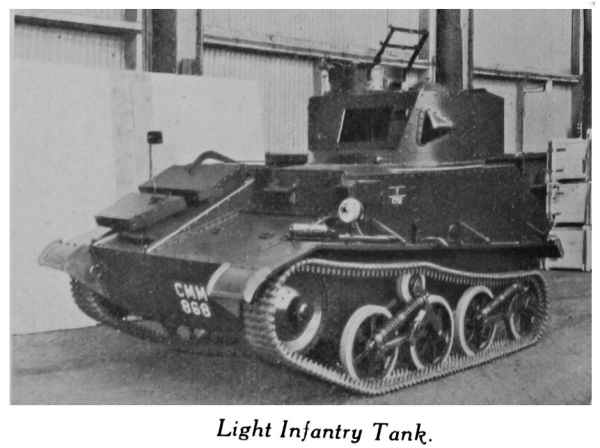 Light Infantry Tank. |
| With the war clouds looming over Europe, Vulcan since the end of 1935, had been building light tanks for the War Office, and in all 250 of these vehicles of the Mark V and Mark VI types were produced and acquitted themselves well in the first desperate months of fighting in Flanders and North Africa. |
In October 1936, the Firm were entrusted with the design of a remarkable and wholly new tank project and in March 1938, the pilot models were completed and ready for trial. Thus was born “Waltzing Matilda,- and having first gone into action on the Western Front in 1940, they roared through the heat and discomfort of the North African Campaign. “Matilda” became a familiar sight in the bitter cold of North Russia and later in the Pacific War Zone. As the War progressed, the Vulcan were given another interesting task, namely the waterproofing of armoured vehicles to enable them to go ashore from landing craft under their own power. Altogether the Vulcan Foundry supplied over 600 Matilda Tanks for the War Office.
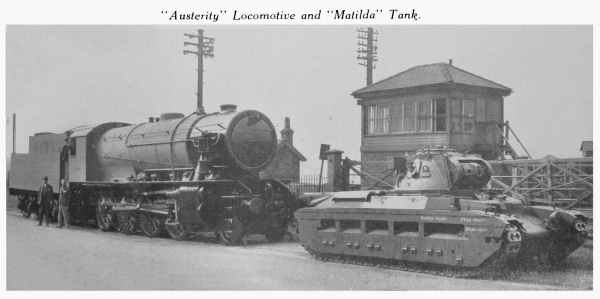 The “Austerity- Locomotive and “Matilda” Tank. |
| Apart from tank production, over 1700 machine-gun mountings of various types were produced in addition to vast quantities of torpedo parts. The major components for torpedoes passed the astounding total of 10,000, while over 40.000 smaller details were supplied. I remember Mr. Lane stating that the output per head at that time surpassed that of any other similar works in the country. |
It is interesting to note that the labour force in April. 1944 reached an all time high of 4,128, the number of women included in this figure being 850, whereas in the first world war female workers employed here did not exceed 400.
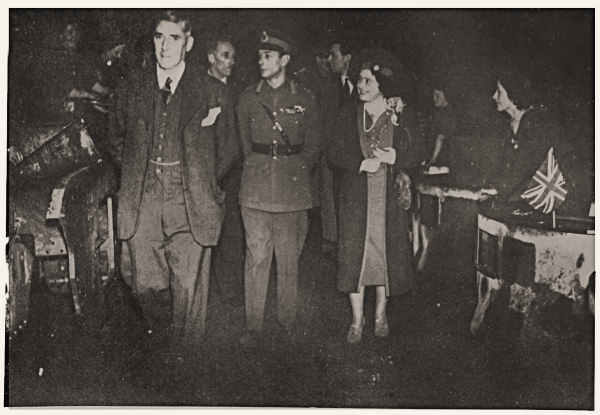 Royal Visit to The Vulcan Foundry. |
| In October 1941, the Company was honoured by a visit from their Majesties the King and Queen, who were conducted on a tour of the Works by Mr. Whalley, Mr. Saunders and other executives of the Firm, amid scenes of great enthusiasm. The accompanying photograph shows Mr. Whalley leading the royal couple through the Tank Assembly Department, and gives some idea of the difficult working conditions necessitated by the black-out. |
Due to the gravity of the transport situation in September 1942, the Firm was requested by the Ministry of Supply to revert to locomotive production, and orders for a large number of 2-8-0 “Austerity” type engines were placed with the Vulcan Foundry, the first locomotive being handed over to the Ministry in January 1943. Simplicity in design was the keynote for the “Austerity” locomotive due to the shortage of certain materials and lack of manpower, and altogether 390 engines of this type were delivered from 1943 to 1945. The last 2-8-0 “Austerity” built in Britain was V.F. rotation No. 5255, and was named “Vulcan” on leaving the Works. To meet the demand for a robust type of shunting locomotive for use in Ordnance Depots and Industrial concerns, fifty 0-6-0 engines were built by the Vulcan Foundry in 1945. Two of these are now in use at the Haydock Collieries of the National Coal Board.
The Vulcan Foundry 2-8-0 “Liberation” Locomotive was a triumph of design for the builders, and a good deal of patience and engineering ability were needed to transmute the requirements of seven countries into the finished engine. The “Liberation” had to be more powerful than the “Austerity” and was designed for universal ‘use on the standard gauge railways of Europe, operating in Luxemburg, Poland, Czechoslovakia and Yugoslavia. Altogether 120 of these engines were produced at the Works in Newton-le-Willows.
On 17th August, 1946, Mr. A. J. Lane retired after serving many years as Works Manager, and was succeeded by Mr. W. E. King.
Mention must be made of the Vulcan Company of the Home Guard (79th West Lancs.) firstly under the command of Major Bolter and later Major Mullen. I joined the Co:npany at its inception and for some time acted as Company Clerk and Secretary of the Entertainments Corn mittee, attaining the rank of private ! I’m afraid I made a poor soldier, the only redeeming feature being that I have always been above the average as a marksman.
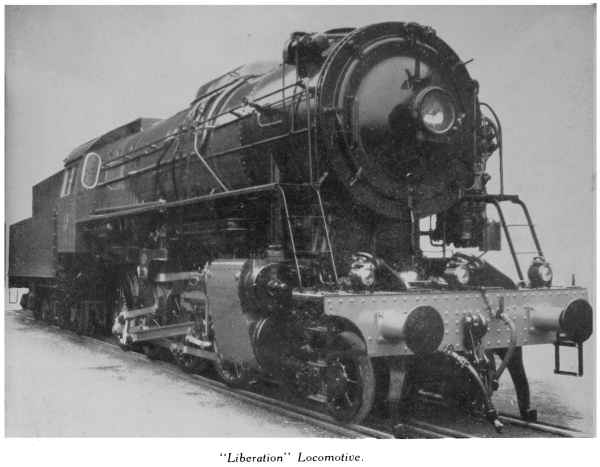 ‘Liberation.’ Locomotive. |
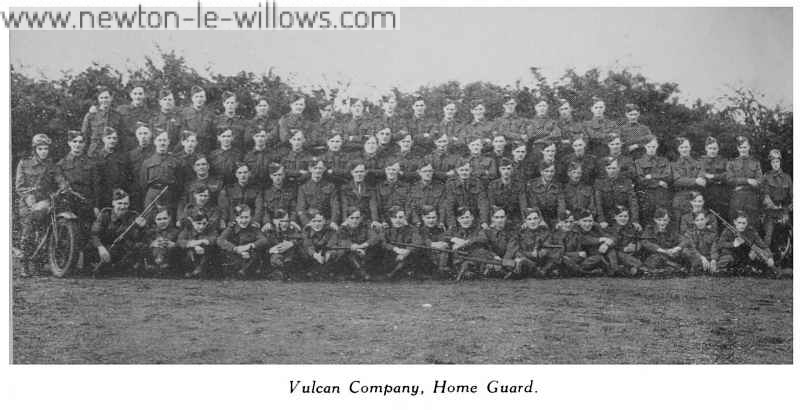 Vulcan Company, Home Guard. |
| My first appearance in the old denim uniform at home, occasioned much merriment, and I remember my wife with caustic sarcasm, remarking that I could dispense with my rifle, as any German would expire with laughter at the first sight of me. However, the Company eventually shook down into one of the smartest and most efficient in the North West. |
Thus ends the short history of this old-established Firm.
I lay no claims to its complete authorship as most of the technical details quoted have appeared in one form or another in a variety of journals and periodicals. One hundred and twenty years of locomotive building—in at the birth and still leading the field in design and craftsmanship over a century afterwards.
Long may It prosper, CARRY ON VULCAN
The text and photos for this article is compiled from various source’s including ‘The Engineer’, J H Lanes, History of Newton-in-Makerfield, The Vulcan Magazines from 1949 and 1950 Vol 1, issues 6, 7, 8 ,9 and 10. Included notes and personal reminiscenses are mostly by Mr H. B. Sansom.
This version of the Vulcan History are ©2007 Steven Dowd and use is restricted to this Newton-le-Willows website
